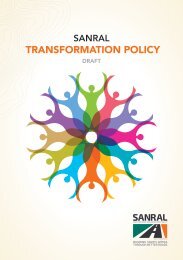Medical Focus - GPH - Vol 3 No 2 250521
You also want an ePaper? Increase the reach of your titles
YUMPU automatically turns print PDFs into web optimized ePapers that Google loves.
The role of NNRTIs in the InSTI era
Dr Bronwyn Bosch MBChB (UCT)
Research Clinician/Safety Physician
Ezintsha, Wits Reproductive Health and HIV Institute, Faculty of Health Sciences, University of the Witwatersrand
Johannesburg, South Africa
ow- to middle-income countries (LMICs) such as our
own are home to around 90% of the global HIV burden
of disease. Despite good progress in aims to achieve
the UNAIDS 90-90-90 targets, factors such as pretreatment
drug resistance, poor treatment adherence and
side effects related to currently available antiretroviral
therapy (ART) regimens pose a threat to continued progress
in this regard, 1 not forgetting the extensive service disruptions
owing to the Covid-19 pandemic. In addition, older ART
regimens comprising high pill burdens, significant side effects
and low barriers to resistance have typically been available in
these settings, contributing to less sustainable regimens. 1 In
recent years, integrase-strand inhibitors such as dolutegravir
have been added as a formidable opponent in first-line ART
regimens in South Africa. With increased use and more
clinical trial data becoming available, however, concerns
around associated weight gain and long-term implications
thereof have raised questions around its suitability for all.
Non-nucleoside reverse transcriptase inhibitors
For much of the HIV pandemic, non-nucleoside reverse
transcriptase inhibitors (NNRTIs) have served as the
cornerstone of combination antiretroviral therapy largely
due to their virologic efficacy, with most first-line regimens
containing either efavirenz (EFV), nevirapine (NVP), or
more recently rilpivirine (RPV) along with two nucleoside
/nucleotide reverse transcriptase inhibitors (NRTIs).
Additionally, NVP has and continues to play a crucial role in
preventing mother-to-child HIV transmission 2 – a particularly
key entry point into HIV care for many women in South Africa.
NNRTIs prevent HIV-1 replication through direct binding
to the reverse transcriptase enzyme, thereby inhibiting its
activity and halting transcription of viral single-stranded RNA
into DNA. 18 Whilst highly effective against HIV-1 infection,
NNRTIs do not show activity against HIV-2 infection and
are not recommended in the treatment thereof. Whilst
predominantly found in West Africa, the prevalence of HIV-2
infection in South Africa is poorly known and not routinely
tested for.
Another significant limitation with older NNRTIs including
EFV, NVP and RPV, is the low genetic barrier to resistance,
requiring only a single mutation to impair clinical efficacy. This
in a country with high rates of non-adherence to treatment,
poses a significant threat to available future options for ART.
Coupled with a high level of cross-resistance within the NNRTI
class, resistant mutations often render multiple drugs useless
in both second and third line ART regimens. 4 Additionally,
transmitted NNRTI resistance is emerging as a major
concern in first-line strategies, particularly in LMICs. Pretreatment
drug resistance (PDR), largely driven by the use
of the NNRTIs EFV and NVP, has continued to increase with
the implementation of combined antiretroviral therapy
(cART), resulting in increased treatment switches 5 and
resultant higher treatment costs. The rates of PDR currently
exceed 10% in most LMICs warranting a change in first-line
antiretrovirals to more robust drug classes as per WHO
recommendations. 1 If not enforced, it has been estimated
that PDR will contribute to over 16% of total deaths, 9% of
new infections and 8% of total cART costs by 2030. 1,6
In South Africa, pre-treatment drug resistance is estimated
to be around 14% and largely driven by NNRTI resistance.
The efficacy of second generation NNRTIs rilpivirine (RPV)
and etravirine (ETR), despite higher genetic barriers to
resistance, are often compromised through NNRTI class
cross-resistance. 7 These resistance mutations are retained in
roughly two-thirds of patients, despite second-line therapy,
and have been elicited in genotyping in more than 65% of
people living with HIV (PLWH) failing second-line ART. 8,9 This
in a country where genotyping is reserved for those failing
second-line therapies, hampers early detection of drug
resistance mutations. Preventing and managing emergent
HIV drug resistance is a key component of the HIV response
and is essential in maintaining first-line, cost effective
therapies for as long as possible.
InSTIs
In response to the above, newer agents for first-line ART
regimens are constantly being evaluated. One such addition
is dolutegravir (DTG), an integrase-strand inhibitor (InSTI),
which was added to the South African ART guidelines in 2019
after being proven non-inferior to multiple different agents
in both first- and second-line ART regimens, including the
local ADVANCE clinical trial comparing 2 DTG regimens to
the previous standard of care (EFV/TDF/FTC). Dolutegravir’s
strength lies in its high genetic barrier to resistance, coupled
with rapid viral load suppression, availability in a fixed dose
combination (alongside TDF/3TC) and overall good tolerability,
with resultant seamless integration into public health care
programmes worldwide. It is estimated that since its rollout in
South Africa in 2019, over 1 million PLWH have been switched
to a dolutegravir-based first-line ART regimen.
However, no drug is without risk. Two particular adverse
effects of concern related to dolutegravir use include
associated weight gain and the potential for neural tube
defects (NTDs) with use in early pregnancy. Whilst the most
13 Vol 3 No 2 - 2021











